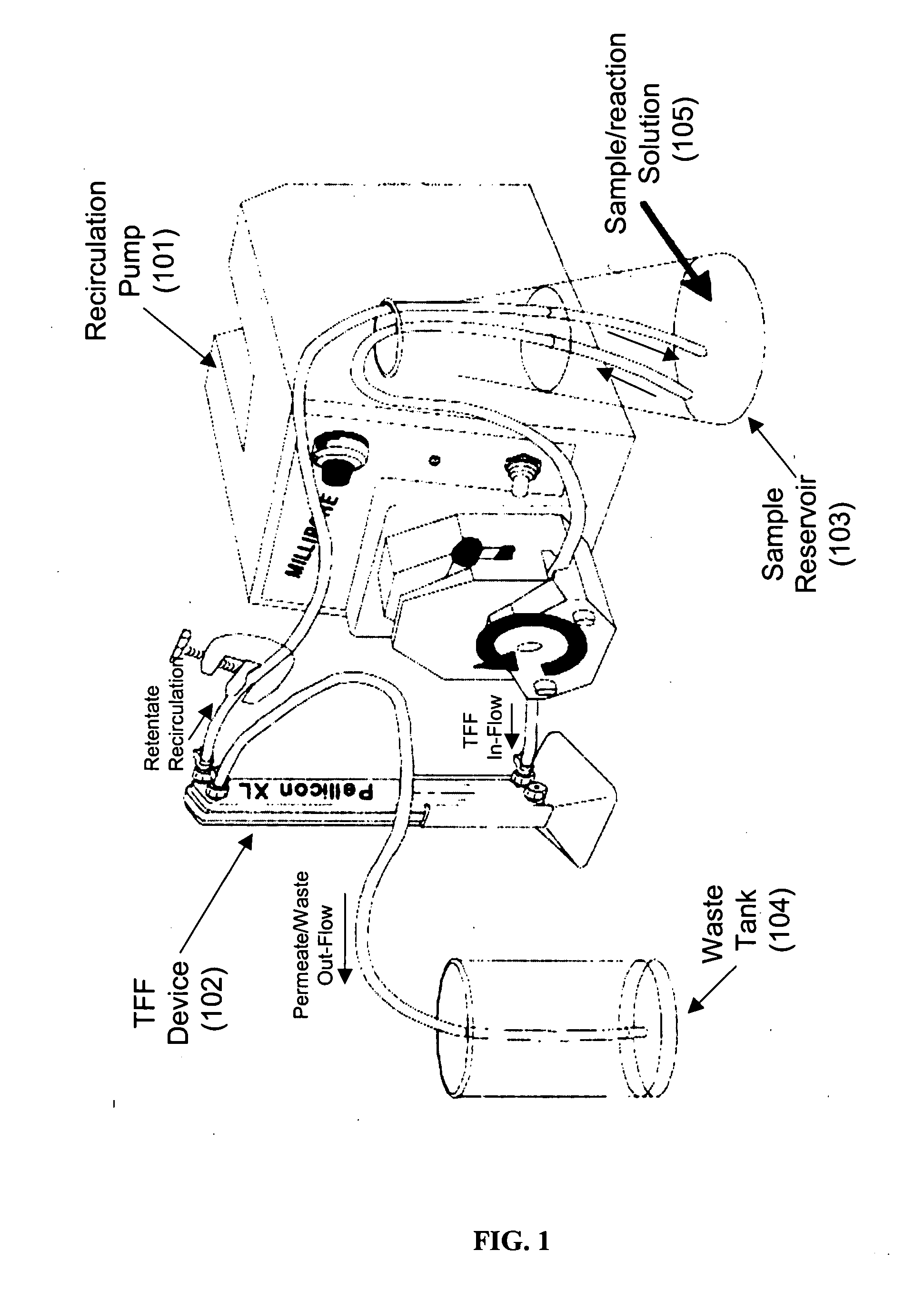Methods of producing antibody conjugates
a technology of conjugates and antibodies, applied in the field of immunology and biochemistry, can solve the problems of sizing columns with relatively low liquid volume throughput limits, excessive undesirable aggregation of clusters comprising multiple antibodies and agents, and cytotoxic agents being conjugated to antibodies, etc., to facilitate the use of much higher antibody concentrations, reduce the risk of cytotoxic agents being exposed to the conjugated antibody, and reduce the risk of cytotoxic agents
- Summary
- Abstract
- Description
- Claims
- Application Information
AI Technical Summary
Benefits of technology
Problems solved by technology
Method used
Image
Examples
example 1
Preparation and Characterization of a vcMMAE Conjugate of the Pr1 Antibody
[0083] Overview
[0084] A high-yield, lab-bench scale process was used to prepare a conjugate of vcMMAE to the anti-TMEFF2 antibody, Pr1. The preparation and characterization of the Pr1 antibody has been previously disclosed in U.S. patent Publication Ser. No. 2004 / 0096392 A1, which is hereby incorporated by reference herein. The preparation and characterization of vcMMAE has been previously disclosed in Doronina, et al., Nature Biotechnology 21: 778-784 (2003). The high quality of the Pr1-vcMMAE conjugate prepared, as described below, was further characterized using spectrophotometry and MALDI-TOF mass spectrometry.
[0085] A. Conjugate Preparation Protocol [0086] 1) Pr1 antibody was provided at ˜20 mg / mL concentration in pH 7.4, PBS. Pr1 concentration was determined spectrophotometrically based on A280 in a 1 cm cuvette using the relation, A280 / 1.4=Ab concentration (mg / mL). In addition, the starting Pr1 anti...
example 2
Preparation of the Pr1-vc-MMAE Conjugate in a Recirculation Apparatus
[0113] The high-yield process for the conjugation of Pr1 with vcMMAE described above may be carried out in a recirculation apparatus according to the method below. The use of recirculation apparatus creates a “single pot” closed system minimizing the risk of exposure to the cytotoxic agent and thereby resulting in greatly enhanced process safety. [0114] 1). The recirculation apparatus (Millipore Corporation, Billerica, Mass.) is assembled as shown in FIG. 1. A sample tank (also called a recirculation tank) is connected to a pump, which is then connected to an ultrafiltration skid (Pellicon XL). The ultrafiltration skid is connected to a waste tank. [0115] 2). 400 mg Pr1 antibody at 20 mg / mL concentration is added to the recirculation tank. A volume of DTT in a 1M stock solution is added to the recirculation tank so that the circulating DTT concentration is 10 mM. The Pr1 antibody and DTT are allowed to incubate a...
example 3
Inhibition of in Vivo Tumor Growth by Pr1-vcMMAE
[0122] To examine the effects of Pr1-vcMMAE in vivo, tumor xenografts of LNCaP (human prostate cancer cells) were grown in immunocompromised male SCID mice and were allowed to reach 50-100 mm3 in size. Mice were then randomized into groups and were treated with Pr1-vcMMAE or a control vcMMAE-conjugated antibody.
[0123] A. Generation of SCID Mice with LNCaP or CWR22 Xenografts
[0124] Immunocompromised mice CB-17 SCID (strain C.B-Igh1 / IcrTac-Prkdc) were purchased from Taconic Farms, (Germantown, N.Y.). Studies were initiated using male mice between the ages of 6-12 weeks (˜20 grams in weight).
[0125] For LNCaP (FGC) implantations, 1×107 cells in 50:50 volume of Iscove's media:matrigel were inoculated subcutaneously on the right flank of animals. For CWR22 tumor fragments were implanted subcutaneously on the right flank of animals. Tumors were allowed to establish until reaching an average of 50-100 mm3 as determined by caliper measurem...
PUM
| Property | Measurement | Unit |
|---|---|---|
| Temperature | aaaaa | aaaaa |
| Temperature | aaaaa | aaaaa |
| Fraction | aaaaa | aaaaa |
Abstract
Description
Claims
Application Information
 Login to View More
Login to View More - R&D
- Intellectual Property
- Life Sciences
- Materials
- Tech Scout
- Unparalleled Data Quality
- Higher Quality Content
- 60% Fewer Hallucinations
Browse by: Latest US Patents, China's latest patents, Technical Efficacy Thesaurus, Application Domain, Technology Topic, Popular Technical Reports.
© 2025 PatSnap. All rights reserved.Legal|Privacy policy|Modern Slavery Act Transparency Statement|Sitemap|About US| Contact US: help@patsnap.com

